Vultures' Zone
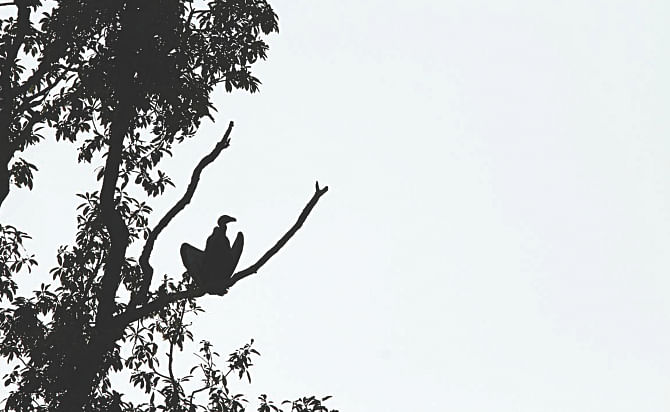
Vultures are termed as natural cleaners. But their prominence in the blue skies of Bangladesh has drastically fallen over the years. From their vast numbers in the previous decades, they have decreased to an estimated number of below 500. Their reduction in numbers is so alarming that they are presently more endangered than the tigers of the Sundarbans.
We walked in the sylvan shadows, taking one step after another, not moving much as if this magic would shatter to something ugly once we make our presence felt. We were soaked in an enchanted world of green, grey, brown and anything in between.
The tree trunks are huge. One measured 28 feet if you went round from one point and returned to it. And the trees are tall, shooting up high in the sky. Some should be as tall as a 30-storey building.
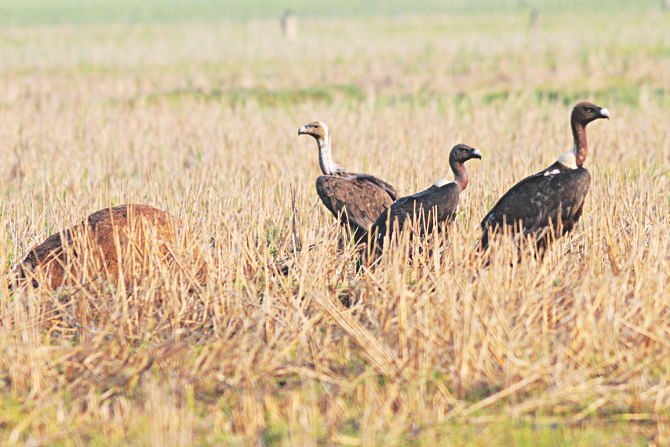
The leaves were thick and dark green. They together spread a leafy canopy above. If you looked up, the sky would splinter through the leaves. Sometimes it's just a green top above you.
Moss grew on the damp trunks. And the creepers hung all around. The mighty banyan trees had wrapped other mighty trees, slowly squeezing them to death. That is Darwin at work.
Damp smell came from the night's dews gathering on the ground, the droplets glinted like diamonds on grass blades. I inhaled the smell.
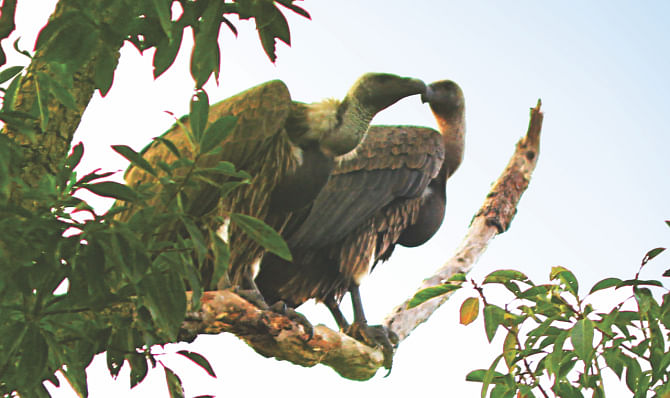
It was an unnaturally quite morning. The birds of the forest had fallen silent because of the cold and mists. Only an occasional flowerpecker would tweet. The loudest noise came from the giant Malayan squirrels that would dart above our head from one branch to another and eye us with suspicion and anger.
I looked around and took in this dreamlike forest; I felt like an insect crawling on the forest floor. Just then it flew past. A large dark shape silently cruised by through the tree branches. Its huge wings spread wide. Its neck stretched out. The flight was so silent that it almost looked like a haunted soul.
I knew we are close to the hotspot. The place where vultures breed.
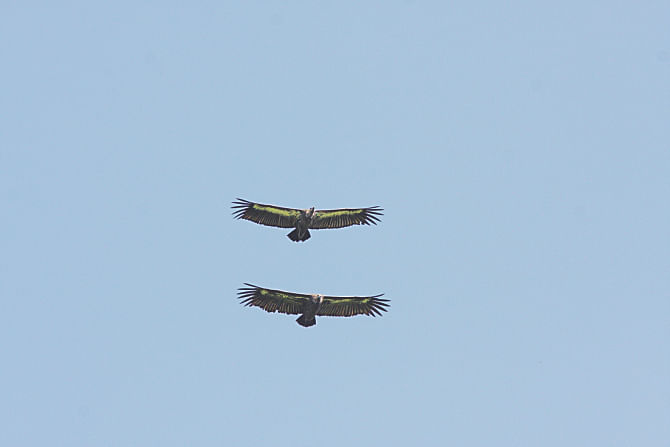
The last time I saw vultures in large flocks was in 1971. I would lie on my back on the open veranda of our home and look up. And there came the vultures. One after another. Hundreds of them. From the direction of Tejgaon Airport they would silently fly past me. Their wings held still in the air. They looked satisfied after eating the corpses, the crops of the ugly war that Pakistan had waged on us.
I would see them perched on the trees beside the rail line in Karwan Bazar. Their tummy full with human flesh. Once we chased one and it was so full of meat that it could not fly.
After that vultures were few and far between in my life. This is not surprising when their population dropped drastically over the past three decades from as many as 90 million to only 10,000 today, making them critically endangered worldwide.
There are a few reasons why this magnificent bird dwindled in numbers. One of them is the use of anti-inflammatory drugs such as diclofenac and ketoprofen in cattle. Vultures are scavengers, living off dead animals.
So when cattle treated with diclofenac die and the vultures feed on them, the medicines work their way into its body system, causing renal failure. Vultures don't have a special enzyme that can break down diclofenac and therefore it hits their kidney badly.
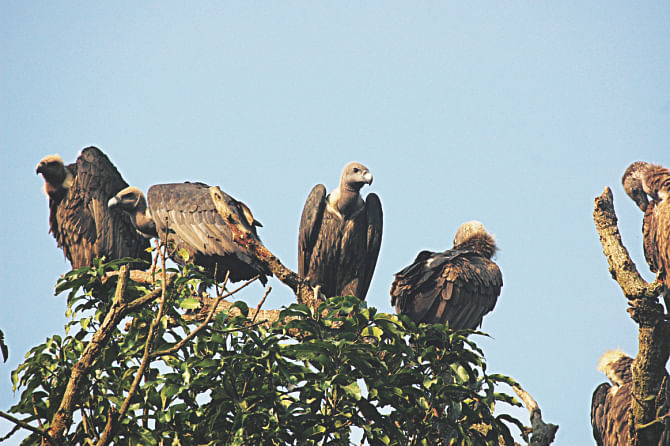
But then there are other reasons too, like loss of habitat and lack of food. Vultures nest on tall trees. But with deforestation such trees are rare. And cattle die less because of better treatment.
Today the situation has come to the point that only about 500 of the majestic birds are now left in Bangladesh. Things could have been on a continuous decline unless environmentalists started raising alarms.
The government also woke up to the concern and banned production and use of diclofenac. And then a Bangladesh National Vulture Recovery Committee was formed.
And a Vulture Safe Zone was declared where no harmful medicines would be allowed for cattle and nesting trees would be maintained.
This is a tough job indeed because a vulture hovers over 30,000 square kilometres in search of food. So a large part of Sylhet and Khulna have fallen under this safe zone where the Bangladesh Forest Department and some NGOs are working, but a recent study conducted by IUCN reveals that around 68% harmful drugs are still available in these zones.
Rema forest where we were standing now happens to be an important place for vultures. Its tall mother trees offer good nesting places.
As we walked in its shadows, past the giant trunks and the myriads of serpentine creepers winding down the trees, we see more of the birds flying behind the trees. We knew we are in the hotspot, a term used to mark the nesting zone.
We stood in the cover of thick bushes and peeked over. About two hundred feet away two vultures were sitting on a tall tree. Below them is a huge scraggy nest. We found eight more nests within an hour. All nests had eggs.
“Nesting season is a critical time for vultures,” says Shimanto Dipu, principal investigator of the White-rumped Vulture Conservation Project of IUCN. “Because vultures are very sensitive birds and any presence of humans would scare them away. This is a real problem for Rema where villagers intrude the forest for firewood and wild roots. They disturb the birds. Often eggs do not hatch if the birds are disturbed too often.”
International Union for Conservation of Nature (IUCN) has undertaken a project and a new approach to establish a sustainable vulture population in the country by preventing the decline of the population through establishing two Vulture Safe Zones. A Vulture Conservation Team has been formed, and it carries out many important tasks like motivating villagers not to go close to the nesting trees during the breeding season.
The team members also visit the veterinary shops to discourage shop owners from selling diclofenac and inform them about alternative medicines.
“Things have improved to some extent,” Dipu says. “Last year we found 17 nests and only eight of them had chicks. This year we have 32 nests and hope there will be more chicks.”
FACT SHEET
Vulture Safe Zone:
A Safe home for vultures
Free (zero tolerance) of diclofenac and other harmful veterinary drugs, which are toxic for vultures
Adequate number of nesting and roosting trees of vulture (in greater Sylhet and greater Khulna)
No human-vulture conflict
Absence of any kind of threats to vultures
Harmful drugs in vulture safe zone:
Main factor for vulture downfall is the use of diclofenac (banned from 2010), a veterinary NSAID (non steroidal anti-inflammatory drug).
Other NSAIDs include- Ketoprofen and flunxin etc.
Open Campaigning:
Awareness creation and open campaigning on the harmful effects of diclofenac, ketoprofen etc. at all levels including government officials, cattle owners, traders, veterinary doctors, pharmacy owners, school children etc.
VCT: Vulture Conservation Team:
VSZ implementation and sustainability of monitoring for conservation of vulture population will depend on capacity of local stakeholders
The project develops site level local committees named as Vulture Conservation Team (VCT)
VCT has been formed in 3 levels -- community level, local level and division level
3 VCT consists of 36 trained people
Through these teams campaigning for sustainable vulture population is ongoing throughout
Vulture Rescue Team:
This team works in collaboration with Bangladesh Forest Department
The rescue team plays an important role during the winter season for vulture conservation
Migratory Himalayan Griffon Vulture comes to our country in the winter months and then dies or falls sick due to shortage of food, among other reasons
The rescue team accommodates the sick or dead vultures for autopsies, tests for Avian Influenza etc.
Pharmacy Survey:
Undercover pharmacy survey (235) was done in 22 out of 64 districts
40% offered ketoprofen, 4% flunixin and 24% offered the outlawed diclofenac
Regional Initiative:
A consortium of like-minded individuals from India, Pakistan, Nepal, Cambodia and Bangladesh are working in the same platform to conserve the vultures of the region. For example -- Vulture Safe Zones in Nepal, Bangladesh, India etc
Also organizations such as SAVE (Saving Asia's Vultures From Extinction) are working towards creating sustainable vulture populations. SAVE's mission is to respond to the vulture crisis in Asia by striving to halt vulture population decline and working to minimise their negative impacts on ecological and human health.
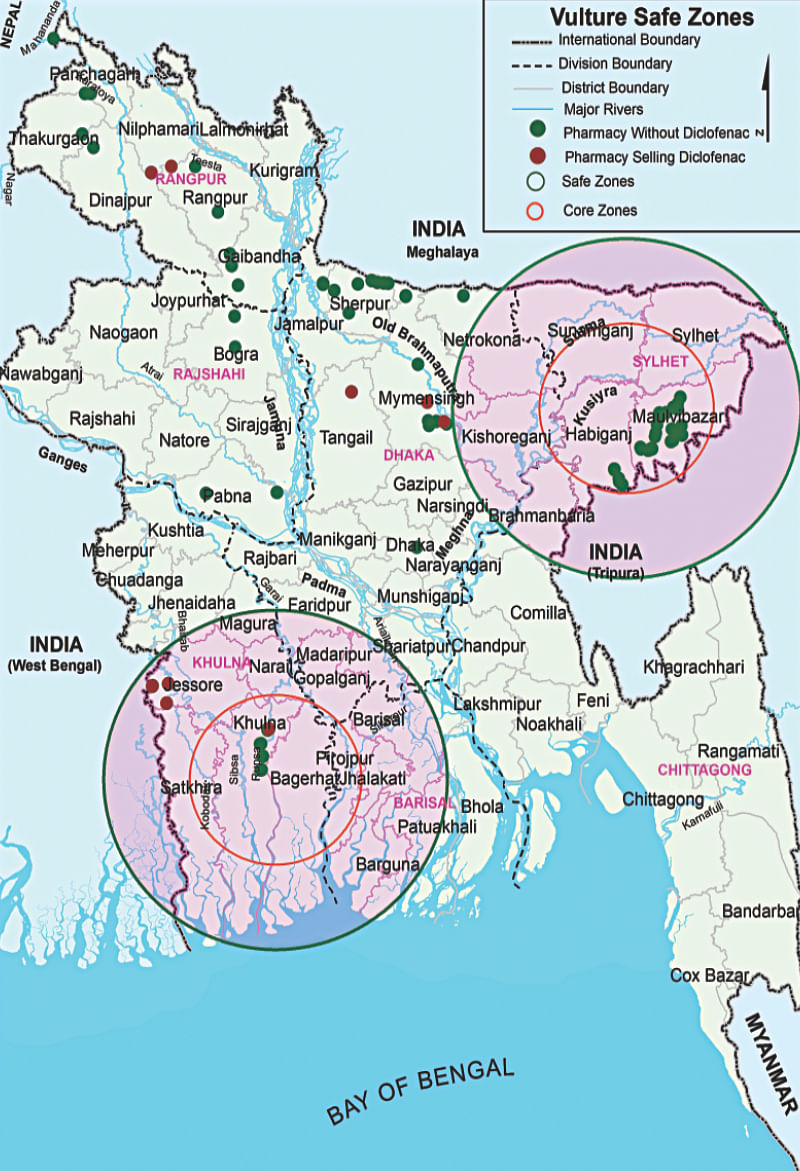

 For all latest news, follow The Daily Star's Google News channel.
For all latest news, follow The Daily Star's Google News channel. 



Comments